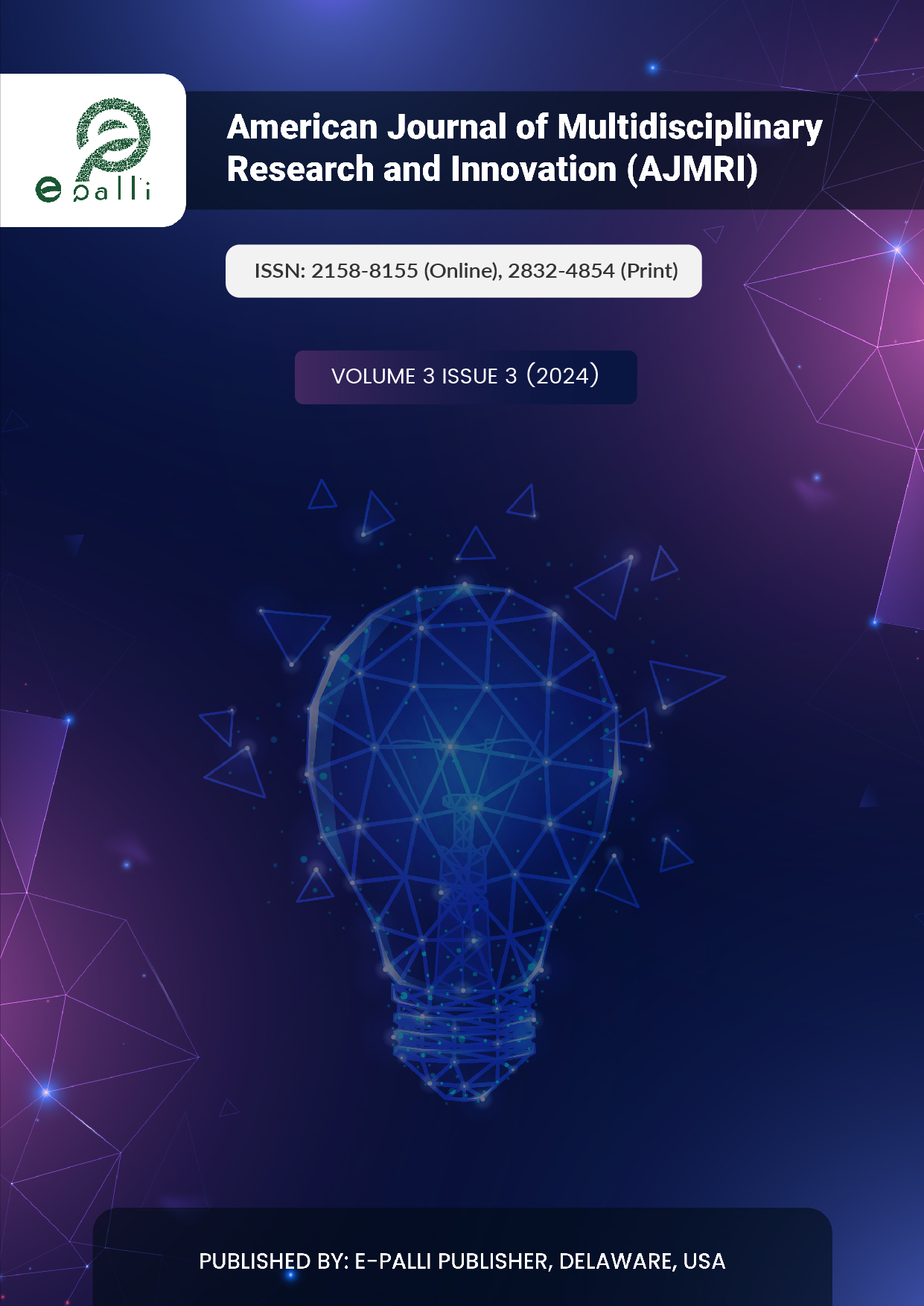A Comparative Evaluation of Multi-Criteria Decision Analysis Techniques for Selecting the Appropriate Vector Management Strategy in the Northern Zone of Plateau State, Nigeria
DOI:
https://doi.org/10.54536/ajmri.v3i3.2717Keywords:
Malaria, Malaria Risk, Correlation, Vector Management, Malaria TransmissionAbstract
Accurate assessment of the complexity of malaria transmission dynamics requires the selection of appropriate Multi-Criteria Decision Analysis (MCDA) techniques that enable thorough analysis of risk factor parameters and structuring of decision problems into well-defined outcomes. A comparative study and analysis of multi-criteria decision-making methods such as TOPSIS, PROMETHEE II, MAUT and COPRAS was carried out using the reference rankings of MULTIMOORA and MOOSRA to evaluate the consistency of the results of these techniques and to rank the risk factors according to the vulnerability of mosquito breeding habitats and the risk of malaria transmission in the study area. The results indicate that TOPSIS ranked the alternative similarly to the reference ranking, while PROMETHEE II, MAUT, and COPRAS were ranked equally according to the weighted Spearman correlation coefficient and the weighted sum rank similarity coefficient analysis. The degree of consistency with which the risk factors in the study area were analyzed through this comparative study shows that the TOPSIS technique is suitable for its application in malaria epidemiology to determine the appropriate intervention measure for vector management in the northern zone of up to certain Plateau State.
Downloads
References
Bączkiewicz, A., Wątróbski, J., Kizielewicz, B., & Sałabun, W. (2021). Towards Objectification of Multi-Criteria Assessments: A Comparative Study on MCDA Methods. Proceedings of the 16th Conference on Computer Science and Intelligence Systems, FedCSIS 2021, 417–425. https://doi.org/10.15439/2021F61
Binbol, N. L., Abdullahi, M. L., & Yusuf, Y. A. (2020). A temporal analysis of rainfall characteristics on the jos plateau, nigeria. https://www.researchgate.net/publication/348779648
Broniewicz, E., & Ogrodnik, K. (2021). A comparative evaluation of multi-criteria analysis methods for sustainable transport. Energies, 14(16). https://doi.org/10.3390/en14165100
Chakraborty, S. (2022). TOPSIS and Modified TOPSIS: A comparative analysis. Decision Analytics Journal, 2, 100021. https://doi.org/10.1016/j.dajour.2021.100021
Diaby, V., Campbell, K., & Goeree, R. (2013). Multi-criteria decision analysis (MCDA) in health care: a bibliometric analysis. Operations research for health care, 2(1-2), 20-24. https://doi.org/10.1016/j.orhc.2013.03.001
Emma Martin, & Burgess Neil. (2022, December 31). Jos Plateau Forest-Grassland _ One Earth. One Earth. https://www.oneearth.org/ecoregions/jos-plateau-forest-grassland/
Goswami, S. S. (2020). Outranking Methods: Promethee i and Promethee II. Foundations of Management, 12(1), 93–110. https://doi.org/10.2478/fman-2020-0008
Guarini, M. R., Battisti, F., & Chiovitti, A. (2018). A methodology for the selection of multi-criteria decision analysis methods in real estate and land management processes. Sustainability (Switzerland), 10(2). https://doi.org/10.3390/su10020507
Ibrahim, D. F., Hassan, A. S., Sani, A., Zakariyya , A., Shema, F. B., Zubair, R. U., & Riruwai, G. Y. (2023). Effect of Aqueous Stem Bark Extract of Parkia Biglobosa on the Histological Morphology of Liver of Adult Wistar Rats. American journal of medical science and innovation, 2(1), 13–20. https://doi.org/10.54536/ajmsi.v2i1.1130
Kassaw, M., Agelo, W. A., Zewdie, A., & Ameneshewa, W. (2018). Identifying Malaria Epidemic Prone Area Hotspot Map by Using Geospatial Technologies and Spatial Multi Criteria Evaluation Techniques: The Case of Majang Zone, Gambella Region, Eth... Identifying Malaria Epidemic Prone Area Hotspot Map by Using Geospatial Technologies and Spatial Multi Criteria Evaluation Techniques: The Case of Majang Zone, Gambella Region, Ethiopia. IOSR Journal Of Humanities And Social Science (IOSR-JHSS.
Lu, J., Zhang, S., Wu, J., & Wei, Y. (2021). Copras method for multiple attribute group decision making under picture fuzzy environment and their application to green supplier selection. Technological and Economic Development of Economy, 27(2), 369–385. https://doi.org/10.3846/tede.2021.14211
Patel, A., Ramana Rao, K. V., Rajwade, Y. A., Saxena, C. K., Singh, K., & Srivastava, A. (2023). Comparative Analysis of MCDA Techniques for Identifying Erosion-Prone Areas in the Burhanpur Watershed in Central India for the Purposes of Sustainable Watershed Management. Water (Switzerland), 15(22). https://doi.org/10.3390/w15223891
Quadri, J. A., Onabanjo, O. O., Oladunjoye, Z. M., & Olusanya, A. G. (2022). Establishing the Nexus Between Iron Status and Markers of Immune Functions Among School Age Children in Ogun State, Nigeria. American Journal of Multidisciplinary Research and Innovation, 1(4), 51–66. https://doi.org/10.54536/ajmri.v1i4.559
Sałabun, W., Watróbski, J., & Shekhovtsov, A. (2020). Are MCDA methods benchmarkable? A comparative study of TOPSIS, VIKOR, COPRAS, and PROMETHEE II methods. Symmetry, 12(9). https://doi.org/10.3390/SYM12091549
Steele, K., Carmel, Y., Cross, J., & Wilcox, C. (2009). Uses and misuses of multicriteria decision analysis (MCDA) in environmental decision making. Risk Analysis: An International Journal, 29(1), 26-33. https://doi.org/10.1111/j.1539-6924.2008.01130.x
Taherdoost, H., & Madanchian, M. (2023). Multi-Criteria Decision Making (MCDM) Methods and Concepts. Encyclopedia, 3(1), 77–87. https://doi.org/10.3390/encyclopedia3010006
Taufik, I., Alam, C. N., Mustofa, Z., Rusdiana, A., & Uriawan, W. (2021). Implementation of Multi-Attribute Utility Theory (MAUT) method for selecting diplomats. IOP Conference Series: Materials Science and Engineering, 1098(3), 032055. https://doi.org/10.1088/1757-899x/1098/3/032055
Wieckowski, J., & Szyjewski, Z. (2022). Practical Study of Selected Multi-Criteria Methods Comparison. Procedia Computer Science, 207, 4565–4573. https://doi.org/10.1016/j.procs.2022.09.520
Yildirim, F. S., Sayan, M., Sanlidag, T., Uzun, B., Ozsahin, D. U., & Ozsahin, I. (2021). Comparative Evaluation of the Treatment of COVID-19 with Multicriteria Decision-Making Techniques. Journal of Healthcare Engineering, 2021. https://doi.org/10.1155/2021/8864522
Youssefi, F., Javad Valadan Zoej, M., Ali Hanafi-Bojd, A., Borahani Dariane, A., Khaki, M., & Safdarinezhad, A. (2022). Predicting the location of larval habitats of Anopheles mosquitoes using remote sensing and soil type data. International Journal of Applied Earth Observation and Geoinformation, 108. https://doi.org/10.1016/j.jag.2022.102746
Zhao, X., Thanapongtharm, W., Lawawirojwong, S., Wei, C., Tang, Y., Zhou, Y., Sun, X., Cui, L., Sattabongkot, J., & Kaewkungwal, J. (2020). Malaria risk map using spatial multi-criteria decision analysis along yunnan border during the pre-elimination period. American Journal of Tropical Medicine and Hygiene, 103(2), 793–809. https://doi.org/10.4269/ajtmh.19-0854
Downloads
Published
How to Cite
Issue
Section
License
Copyright (c) 2024 Nanlok Henry Nmimlang, Gilles Dusserre, Sandrine Bayle, Kivanc Ertugay, Stefan Janaqi

This work is licensed under a Creative Commons Attribution 4.0 International License.







